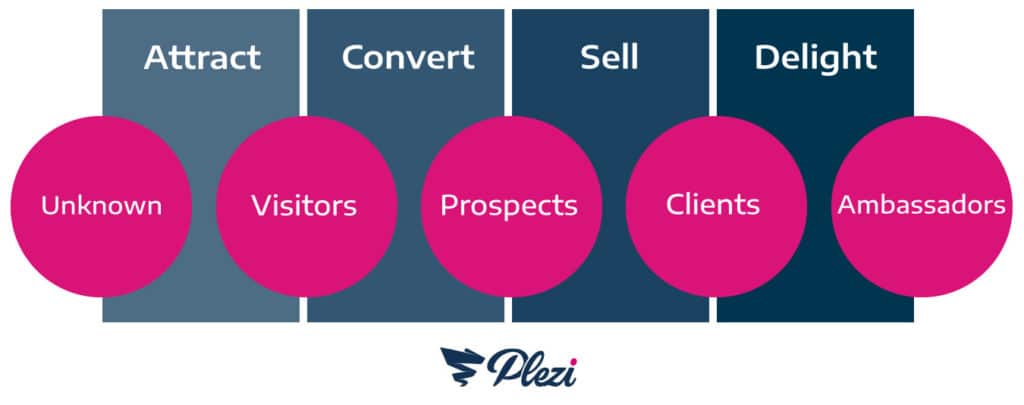What if lead generation wasn’t your only priority? In B2B, we often imagine that generating leads is the number one issue. But the truth is… the next step is just as important.
By “next step” we mean: managing leads. Because it’s not enough to generate leads in quantity… You also have to know how to manage them, with a quality strategy!
Discover in this article how to set up a good lead management process. To generate qualified contacts AND know how to manage them efficiently.
What is a lead?
A lead is a contact who has shown an interest in the company, for example at a trade show or by responding to an e-mailing. This potential customer is considered a “lead” when the company has sufficient information about him (first and last name, company name, e-mail, telephone, etc.).
We then consider that a lead can become a prospect, when it is qualified enough to be passed on to a sales representative. But be careful! The crucial difference between a lead and a prospect is that the former shows an interest in the company, while the latter states its intention.
In B2B, we consider that a lead can be generated by sales prospecting… or by the efforts of marketing teams. Regardless of which team is responsible for obtaining the lead, this stage is referred to as “lead generation“.
Lead generation is a strategy that aims to attract visitors and turn them into qualified leads. It is the first step of the customer acquisition process. Here are its objectives:
- Collect the contact information (email, phone number) of the future lead
- Generate a database of prospects at different stages of the sales cycle
- Demonstrate the value of your offer and how it is differentiated
- Convert ready-to-buy prospects into customers, and boost the company’s growth
To succeed in a lead generation strategy, the ideal is to rely on Inbound Marketing. This method allows to arouse the curiosity and interest of the audience for the company, thanks to quality content. And if you’re wondering “how to generate qualified leads, especially through Inbound Marketing?”… You know where to click, to discover all our techniques.
But be careful! Your priority is not only to define THE best strategy, to generate leads. Have you thought about the next step, which is to manage the qualified leads?
What is lead management?
Lead management is a process that comes after lead generation. Once qualified contacts have been generated, the objective is to learn how to “manage” them.
At this stage of lead management, the challenge is to follow up on potential buyers and to maintain a close relationship with them, by informing them and interacting with them regularly. All this to successfully transfer them from the marketing department to the sales team, in order to convert them into loyal customers. According to a SmartInsights study, an optimized lead management process has a 93% higher sales ratio than others!
To avoid holes in the pipeline (and your visitors falling through, never turning into a qualified lead), every B2B company must take care of its lead management process.
For example, to effectively manage a lead and follow its evolution throughout the buying process, here are some key steps
- Succeed (smoothly) in the lead generation stage. Without this, it is difficult to move on to the next steps. To achieve this, remember to collect enough information about your contacts (for example, through a form).
- Understand the needs of your leads. Here, we advise you to analyze the demographic and behavioral data of your contacts. Also study the source of your leads. By understanding where they come from, you will know more precisely what they want.
- Implement appropriate actions: each lead goes through different phases of the funnel. It can be managed by marketing, then sales teams… Or both at the same time! Each situation leads to the implementation of adapted actions. For example, if the lead is managed by both teams, invite the sales teams to maintain the relationship with the prospect by phone… And invite the marketing teams to deploy a personalized content strategy to mature the lead. For example, with Plezi’s smart campaign.
4 tips to set up a good lead management process
Don’t you fear the lead management stage anymore? Good for you. But before jumping into the deep end, here are some tips to set up a good lead management process… Without ever ending up with your head under water.
1. Automate lead capture
Marketing automation is an essential tool for lead management. With a specialized tool (like Plezi), you save time and effort to manage your qualified leads.
Our marketing automation solution allows you to capture leads directly on your website, to collect important demographic and behavioral data… And to start the conversation automatically, for example through a welcome workflow.
This welcome workflow is important content. It is often the first direct contact with your lead: use it to gently introduce your offer and build trust with your audience. With software like Plezi, this workflow has the advantage of “running itself”, thanks to the smart lists and forms deployed.
In short: marketing automation (especially via upstream lead capture) is a powerful lever for your lead management strategy. Automation facilitates the qualification of leads by marketing… And their transfer to sales teams, to turn them into customers!
2. Prioritize the best leads with lead scoring
Lead scoring is essential for a successful lead management strategy. With lead scoring, the company assigns a score to each qualified contact, based on various criteria: demographics, lead behavior on the site, campaigns, etc.
This method helps determine the maturity of leads throughout the buying process and their potential interest in a product or service. Indeed, lead scoring facilitates the identification of the most qualified leads, which can be quickly and easily passed on to the sales teams.
Each score assigned gives precise indications on lead management. For example, the higher the score, the higher the probability of conversion. Such a qualified lead can then be quickly sent to the sales team.
On the contrary, the lower the score, the more marketing efforts the company will have to make… Especially through lead nurturing, to increase the chances of integration into the conversion funnel.
To achieve this, don’t hesitate to maintain the relationship with personalized content, until the lead is mature enough to be transferred to the sales team. According to Forrester Research, companies with effective lead nurturing generate 50% more sales, for a 33% lower cost!
3. Put an SLA in place
61% of B2B marketers send unqualified leads to sales, according to MarketingSherpa. What if this wasted time and inefficiency could be avoided, thanks to a contractual document?
Lead management is a dual responsibility strategy, for the marketing team… But also for the sales team. To align both departments on the same process, one document is particularly useful: the SLA.
The Service Level Agreement (SLA) defines, documents and contracts the conditions of a collaboration between two parties. In business, it is more commonly referred to as a Smarketing SLA (a contraction of sales and marketing), to define the rules of the game in terms of lead management, for sales and marketing teams.
Such a document responds to a major challenge: nowadays, it is no longer (at all) in the interest of companies to operate in silos. Marketing and sales need to be aligned, to move forward hand in hand (rather than back to back). And to avoid turf wars or misunderstandings, the SLA is a golden ally. Its ultimate advantage? Formalize and promote an optimal transfer of leads from the marketing department to the sales department.
You’ve got it: the SLA optimizes the lead management strategy, since it contracts the operation of the process and the role of each team. This document makes each stakeholder responsible, by answering the questions: when, how, why, how often and how many times a lead must be addressed by each department.
4. Follow shared dashboards
The key to an efficient lead management process? It is above all to have a good collective follow-up, between the marketing and sales teams.
To achieve this, consider creating and sharing common dashboards. These tools help to better understand the results of lead management, to detect potential problems and to improve lead processing, for better performance.
To cross the different views of sales and marketing teams, we also recommend synchronizing your CRM and marketing automation software. A marketing automation tool like Plezi can synchronize with most CRMs like Salesforce, Zoho, HubSpot or Pipedrive.
According to a study by Focus Research, three quarters of companies that have integrated their marketing automation software with their CRM see a return on investment within 12 months. This synchronization allows you to :
- Automatically transfer qualified leads from marketing to sales teams.
- Improve contact targeting and segmentation.
- Easily track the impact of marketing actions on sales results: number of visitors to the website, conversion rate of visitors into leads, cost per lead, number of appointments scheduled and number of sales closed, etc.
With shared dashboards and a good synchronization of tools, success is guaranteed: your different teams have access to the same information, to optimize the lead management strategy jointly.
Without leads, there is nothing. In business, these qualified contacts are the lifeblood of the company. But it is not enough to generate a large number of them! After lead generation (the first step in the conversion funnel), the objective is to effectively manage their entire life cycle. This is called lead management.
To summarize, here are the different stages of lead management:
- Lead generation
- Lead sorting and qualification
- Lead scoring
- Transferring leads to the sales team
- Prospecting and/or nurturing
- Sales
This whole lead management process is a joint responsibility, shared between the marketing and sales teams. In this article, you have discovered our 4 tips to maximize your chances of success and efficiency throughout the process. Now… it’s your turn. On your leads, get set… Manage!






